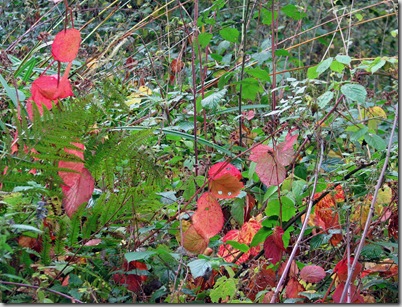Despite its leg-clawing thorns and trip-wire bines or canes, our wild brambles have many virtues. Their white or pink flowers are much loved by summer butterflies and beetles, the gleaming black fruits are one of the few wild berries (actually an 'aggregate fruit' not a 'berry') one can eat directly from the plant and their leaves feed a host of different insects.
In autumn most bramble leaves go dull green or purplish, but occasionally they develop much richer reds and golds (like those below photographed in the old Brede High Woods wood yard) to add to the general autumn fires.
Like many British plants, much virtue has been ascribed to lotions and potions made from the leaves. They are said to help heart disease and some cancers while "bramble leaf tea is a well-known remedy for diarrhoea, sore throats and mouth ulcers. Because of its high vitamin and mineral content, it also acts as a good tonic." I think perhaps the term 'well-known' is a little optimistic.
Perhaps, in accordance with the doctrine of signatures, those reddening leaves are thought to resemble the inflamed parts of the body.
I also discovered that split bramble bines are used in making lip work or straw work baskets or chairs. There is an account of this here: http://pilgrim.ceredigion.gov.uk/index.cfm?articleid=2299
I love the passage that says "the second coil is laced through that of the previous coil with the aid of a pointed bone from a horse's leg."
